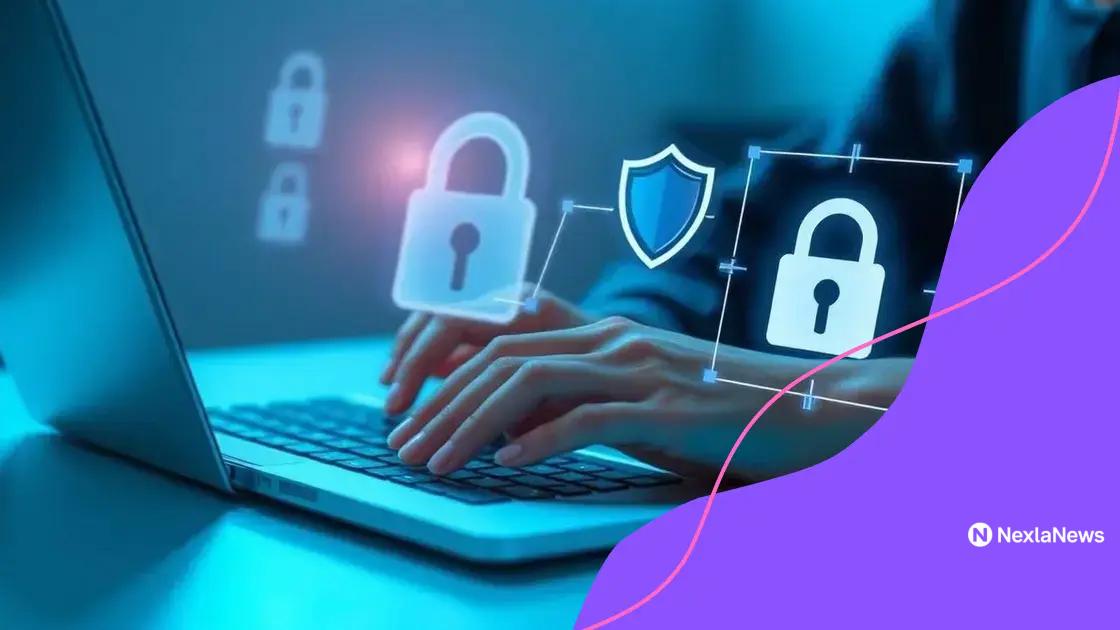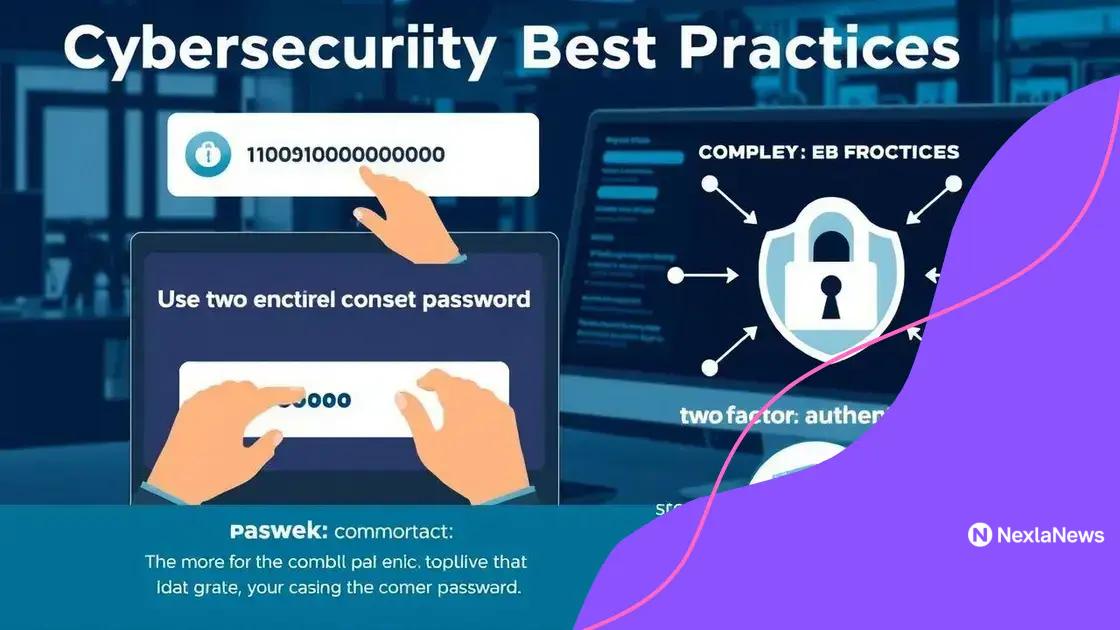Cyber threats rise: how to protect your data effectively

Staying informed about rising cybersecurity threats is essential for protecting your data, utilizing resources like blogs, courses, podcasts, and community forums to enhance your knowledge and defenses against cyber attacks.
Cyber threats rise every day, impacting everyone from individuals to large corporations. Have you considered how secure your data truly is? Let’s dive into what’s really at stake and how you can protect yourself.
Understanding the landscape of cyber threats
In today’s digital world, understanding the landscape of cyber threats is crucial for maintaining security. Each day, new vulnerabilities emerge that can impact our personal and professional lives.
Cyber threats come in various forms, targeting both individuals and organizations. Being aware of these threats is the first step toward safeguarding valuable data.
Common Cyber Threats
Among the numerous types of cyber threats, a few stand out as the most frequent:
- Phishing: This method tricks users into revealing sensitive information.
- Malware: Malicious software designed to damage or disable devices.
- Ransomware: A serious threat that locks your data and demands payment for access.
Recognizing these threats plays a vital role in prevention. It’s also essential to understand how they operate. For example, phishing attacks often appear as legitimate emails, making it difficult to spot them. Similarly, malware can hide in seemingly harmless software.
Staying Informed
As the world of technology evolves, so do cyber threats. They’re constantly changing, requiring us to stay informed about the latest trends and tactics used by cybercriminals. Regularly updated security practices can shield your personal information from being compromised.
One effective way to stay ahead is to subscribe to cybersecurity newsletters or follow expert blogs. These resources provide insights into emerging threats and how to defend against them. Additionally, participating in online security courses can enhance your understanding and preparedness.
By understanding the landscape of cyber threats, individuals and businesses can take proactive steps to ensure their data remains secure. Awareness not only decreases risks but also builds a culture of security-mindedness.
Common types of cyber attacks
Understanding common types of cyber attacks is essential for anyone using the internet today. These attacks can affect personal security and compromise company data.
Among the most frequent types of cyber attacks, several methods stand out. By recognizing how these attacks work, you can better protect yourself.
Types of Cyber Attacks
Here are some typical cyber attacks that you should be aware of:
- Phishing: This tactic uses fake emails or messages to steal personal information.
- Malware: A broad category that includes malicious software designed to disrupt or damage systems.
- DDoS attacks: These attacks overwhelm a website or service with traffic, making it unavailable.
- Ransomware: A severe threat that locks users out of their files and demands a ransom to regain access.
Knowing the tactics of cybercriminals helps in preventing these damaging attacks. For example, phishing often appears as a believable email, tricking users into clicking malicious links. Similarly, malware can attach itself to legitimate programs, spreading without detection.
Impact of Cyber Attacks
The impact of these attacks can be devastating. A successful cyber attack can lead to loss of data, financial loss, and damage to reputation. Organizations, in particular, must be vigilant to maintain their credibility and trust with customers.
To mitigate the risks, individuals and businesses should invest in cybersecurity tools that can help detect potential threats. Keeping software updated is also a key step in preventing exploits. The landscape of cyber attacks is always changing, which makes it vital to remain informed and proactive.
Best practices for securing your information

Implementing the best practices for securing your information is vital in today’s digital environment. Every user needs to take steps to safeguard their data from potential cyber threats.
One key practice is to create strong passwords. A strong password should include a mix of letters, numbers, and special characters. Avoid using easily guessed information, like birthdays or common words. Additionally, it’s essential to change passwords regularly.
Using Two-Factor Authentication
Another effective way to enhance security is by enabling two-factor authentication (2FA) wherever possible. This method adds an extra layer of protection, requiring not only a password but also a second form of verification.
- Text message codes: Receive a code via SMS when logging in.
- Authenticator apps: Use apps like Google Authenticator to generate temporary codes.
- Email confirmation: Get a verification code sent to your email.
In addition to using strong passwords and 2FA, being cautious about public Wi-Fi is crucial. Public networks can expose sensitive data to cybercriminals. If you must use public Wi-Fi, consider utilizing a Virtual Private Network (VPN) to encrypt your data.
Regular Updates and Backups
Consistently updating software and applications is another best practice. Updates often include security patches that protect against the latest threats. Failing to update can leave your system vulnerable.
You should also regularly back up important data. Use cloud storage or external hard drives to keep copies of crucial files. By backing up data, you reduce the risk of loss from a cyber attack.
Educating yourself about cyber threats can significantly improve your personal security. Stay informed on the latest trends and tactics used by cybercriminals. Awareness leads to better decision-making and can protect your valuable information.
Emerging trends in cybersecurity threats
Staying ahead in the digital world means being aware of emerging trends in cybersecurity threats. As technology evolves, so do the methods used by cybercriminals.
One of the key trends is the rise of sophisticated phishing attacks. Unlike traditional phishing, new techniques exploit social media to appear more legitimate. Attackers are using personalized information to trick users into revealing sensitive data.
AI in Cyber Attacks
Another trend is the use of artificial intelligence (AI) by cybercriminals. AI enables attackers to automate processes and create more convincing attacks. For instance, they can analyze data to craft targeted phishing messages that are hard to distinguish from genuine communication.
- Deepfakes: AI can create realistic fake videos or audio, making it easier to impersonate individuals.
- Automated Attacks: Bots can execute attacks on a larger scale, affecting more victims in less time.
- Algorithm Exploitation: Attackers analyze algorithms to find vulnerabilities in software quickly.
Moreover, the Internet of Things (IoT) has introduced a new level of risk. As more devices connect to the internet, each device becomes a potential target. Insecure devices can be used by cybercriminals to gain access to larger networks.
Ransomware Evolution
The evolution of ransomware is another critical trend. Attackers are not just encrypting data; they are also stealing it and demanding ransom for both access to the data and non-disclosure of the theft. This dual-threat approach increases pressure on victims to pay.
Finally, supply chain attacks are gaining prominence. Cybercriminals target less-secure elements of a supply chain to compromise larger organizations. By infiltrating trusted vendors or partners, they can reach more sensitive systems.
Understanding these emerging trends in cybersecurity threats is essential for developing effective defense strategies. Being proactive and staying informed will help you better protect yourself and your organization.
Resources for staying informed and prepared
Staying informed about cybersecurity threats is essential in today’s digital age. With the rapid evolution of technology, knowledge is your best defense.
One valuable resource is online cybersecurity blogs. They cover the latest trends, threats, and tips for protecting your information. Following reputable blogs can provide insights that keep you ahead of potential risks.
Online Courses and Webinars
Participating in online courses and webinars is another way to enhance your understanding of cybersecurity. Many universities and organizations offer free or low-cost programs. These courses can teach you about various topics, from identifying phishing attempts to securing networks.
- Coursera: Offers courses from leading universities on cybersecurity.
- edX: Provides various cybersecurity classes, many free to audit.
- Webinars from security experts: Attend live sessions to learn about current threats.
In addition to courses, subscribing to cybersecurity newsletters can be extremely helpful. These newsletters provide updates, case studies, and best practices directly to your inbox. Staying updated with the latest news keeps your knowledge fresh and relevant.
Podcasts and YouTube Channels
Podcasts are another fantastic resource. Many cybersecurity experts host podcasts that discuss recent trends and incidents. This format allows you to learn while commuting or doing other tasks.
YouTube channels dedicated to cybersecurity offer visual and practical knowledge. They provide tutorials, explain new security tools, and share insights on current cybersecurity events. Watching these videos can help you absorb information quickly.
Joining online communities and forums is also effective for sharing experiences and learning from others. You can ask questions and engage with cybersecurity professionals and enthusiasts. This interaction can prove invaluable for gaining practical knowledge.
FAQ – Frequently Asked Questions about Cybersecurity Awareness
What are the most common types of cyber threats?
The most common types of cyber threats include phishing attacks, malware, ransomware, and DDoS attacks. Awareness is key to prevention.
How can I protect my information online?
To protect your information, use strong passwords, enable two-factor authentication, and be cautious when using public Wi-Fi.
Why is it important to stay informed about cybersecurity?
Staying informed helps you understand evolving threats and improve your defenses, making it easier to protect your personal and business data.
What resources can I use to learn more about cybersecurity?
Resources include cybersecurity blogs, online courses, podcasts, and community forums that connect you with experts and provide the latest information.
